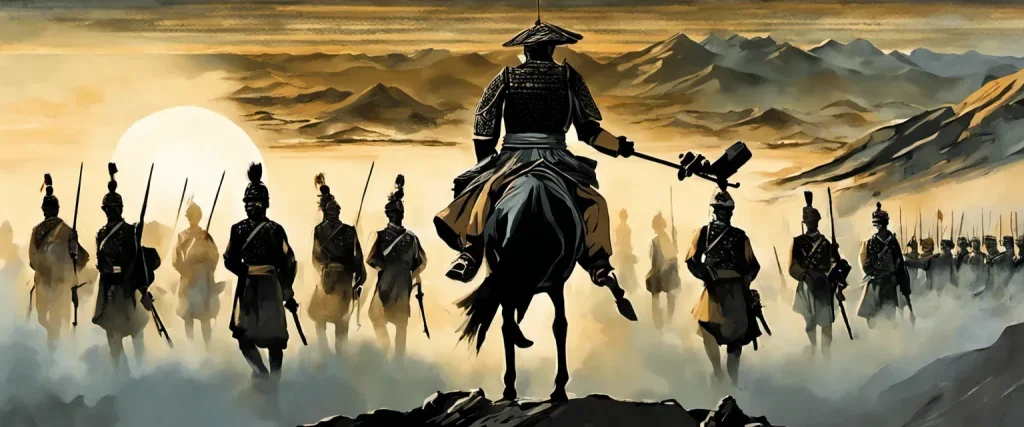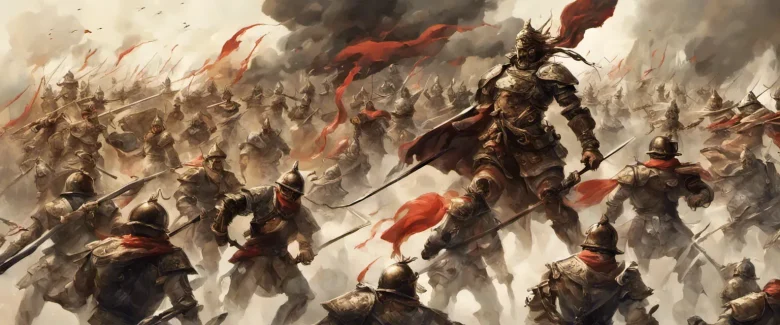The Art of War, an ancient Chinese military treatise written by Sun Tzu, is a timeless masterpiece that explores the philosophy and strategies of warfare. Sun Tzu, believed to have lived around the 5th century BCE, was a Chinese military general and strategist. Though much of his life remains shrouded in mystery, his profound insights on military tactics and leadership have had a significant impact on military thinking for centuries. The Art of War not only offers guidance on strategic planning and combat, but also delves into the importance of understanding oneself, the enemy, and the ever-changing nature of conflict. This summary will provide a concise overview of Sun Tzu’s crucial teachings and their relevance in various domains beyond the battlefield.
Chapter 1: The Importance of Strategy
Chapter 1: The Importance of Strategy serves as an introductory chapter to Sun Tzu’s acclaimed book, The Art of War. In this chapter, Sun Tzu emphasizes the significance of strategy in warfare and highlights several essential principles for successful military operations.
The chapter begins by stating that warfare is of utmost importance to a nation’s survival, and it should not be neglected. Sun Tzu asserts that strategy is crucial in securing victory, as it is the means by which one can obtain advantages over an opponent. He emphasizes that careful planning and preparation are paramount to achieve success on the battlefield.
Sun Tzu introduces the concept of “The Tao,” which emphasizes the importance of understanding oneself, the enemy, and the terrain. This knowledge is necessary to exploit the enemy’s weaknesses and to leverage one’s own strengths effectively. Sun Tzu emphasizes the need for flexibility and adaptability, as strategies must be adjusted based on the changing circumstances of a particular conflict.
Additionally, the chapter emphasizes the significance of leadership in strategy. Sun Tzu advises that leaders must possess qualities like intelligence, trustworthiness, and cunning to succeed. He warns against recklessness and impatience, urging leaders to make sound decisions based on thorough analysis.
Furthermore, Sun Tzu highlights that victory should be achieved through tactics that minimize bloodshed and destruction. He encourages leaders to seek ways to defeat the enemy without engaging in unnecessary conflict, emphasizing the importance of efficient and prudent decision-making.
In summary, Chapter 1 emphasizes that strategy is essential in warfare and provides a foundation for subsequent chapters, which delve into various tactics and principles for success. Sun Tzu’s teachings revolve around knowing oneself and the enemy, adapting strategies to the circumstances, and employing leadership qualities to secure victory efficiently.
Chapter 2: Waging War
Chapter 2 of “The Art of War” by Sun Tzu is titled “Waging War.” In this chapter, Sun Tzu explores various elements that are essential for a successful campaign.
The chapter begins by emphasizing the importance of fully understanding one’s own strengths and weaknesses, as well as those of the enemy. He advises that a commander must accurately assess the terrain, the climate, and the available resources before engaging in battle. According to Sun Tzu, knowing these factors will allow the strategist to capitalize on advantages and exploit the vulnerabilities of the opponent.
Sun Tzu also stresses the significance of efficient organization and strategic planning. He emphasizes that victorious commanders must be prepared for various scenarios and maintain flexibility in their strategies. Sun Tzu encourages commanders to proactively shape the battlefield, positioning their forces in advantageous positions to maximize offensive capabilities and minimize the risks.
Furthermore, the chapter highlights the importance of information and intelligence gathering. Sun Tzu states that accurate and timely information is crucial to make informed decisions during times of war. He explains the significance of spies and espionage, stating that the cultivation of reliable sources within the enemy’s ranks can provide valuable information and contribute to the ultimate victory.
Sun Tzu concludes the chapter by emphasizing the importance of unity of purpose and maintaining the morale of troops. He believes that a united and disciplined army will be more resilient and effective on the battlefield. Sun Tzu advises commanders to understand the psychology of soldiers, using techniques such as rewards and punishments to motivate and boost morale.
In summary, Chapter 2 of “The Art of War” provides essential insights into the key elements necessary for waging successful warfare. These include understanding one’s own strengths and weaknesses, assessing the enemy’s position, efficient organization and strategic planning, gathering accurate information, and maintaining unity and morale within one’s own troops. Following these principles, according to Sun Tzu, can greatly increase the chances of triumph in warfare.
Chapter 3: Strategic Attack
Chapter 3: Strategic Attack of “The Art of War” by Sun Tzu delves into the importance of a strategic offensive approach and the various methods to weaken the enemy effectively. Sun Tzu emphasizes that victory can be achieved by avoiding battles and focusing on undermining the enemy’s strength.
The chapter highlights the significance of attacking the enemy’s strategy and alliances rather than engaging in direct confrontations. Sun Tzu emphasizes the importance of understanding the enemy’s plans and utilizing tactics to disrupt their initiatives. He suggests that attacking the enemy’s strategy can destabilize their forces and create confusion among their ranks.
Sun Tzu emphasizes the use of deception and surprise as effective strategies. He advises attacking the enemy’s weakest points while avoiding their strongest defenses. This involves studying the enemy’s vulnerabilities and exploiting them through carefully planned maneuvers. By attacking when the opponent least expects it, one can disrupt their plans and gain an upper hand.
Furthermore, the chapter emphasizes the importance of attacking an enemy’s alliances and breaking their unity. Sun Tzu suggests manipulating the enemy’s relationships with their allies, weakening their support and creating divisions within their ranks. By isolating the enemy, one can reduce their strength and increase the chances of victory.
Overall, Chapter 3 of “The Art of War” highlights the importance of strategic attack as a means to defeat the enemy. Sun Tzu elucidates the significance of understanding the enemy’s plans and exploiting their weaknesses, utilizing deception, surprise, and attacking alliances to undermine their strength. This chapter serves as a guide to achieving victory through calculated and strategic offensive actions.

Chapter 4: Tactical Dispositions
Chapter 4 of “The Art of War” by Sun Tzu titled “Tactical Dispositions” focuses on the importance of strategic positioning and adaptability in achieving victory in warfare. The chapter offers valuable insights into the various tactics and formations that can be employed to outmaneuver the enemy and seize the advantage on the battlefield.
Sun Tzu emphasizes the need for commanders to remain flexible and adaptable to the ever-changing conditions of war. He discusses different types of terrains, such as open, narrow, or contested environments, and suggests appropriate tactics for each situation. For instance, he advises using narrow passages to create chokepoints where the enemy’s forces can be weakened, giving oneself the upper hand.
The chapter also emphasizes the significance of intelligence in warfare. Sun Tzu stresses the importance of gathering accurate information about the enemy’s strengths, weaknesses, and intentions. By understanding these factors, commanders can make informed decisions and develop effective strategies to exploit any weaknesses or vulnerabilities.
Moreover, Sun Tzu highlights the value of unpredictability and surprise in battle. He urges commanders to cultivate the element of surprise through deception and strategic movement. By misleading the enemy and gaining an element of surprise, one can disrupt the enemy’s plans and seize the initiative.
Throughout the chapter, Sun Tzu emphasizes the importance of planning and preparation. He believes that a well-thought-out strategy, based on comprehensive knowledge and analysis, along with flexibility and adaptability, is essential for victory in warfare.
Overall, this chapter provides a detailed analysis of various tactical dispositions, emphasizing the importance of strategic positioning, adaptability, intelligence, and surprise in achieving success on the battlefield. By implementing these principles, commanders can maximize their chances of victory by exploiting the weaknesses of their enemies while mitigating their own vulnerabilities.
Chapter 5: Energy and Strength
Chapter 5 of “The Art of War” by Sun Tzu focuses on the importance of energy and strength in military tactics and strategies. According to Sun Tzu, a commander must understand how to effectively utilize and preserve these resources in order to achieve victory on the battlefield.
Sun Tzu begins by explaining that energy is the combination of a commander’s strong personality, willpower, and ability to inspire and motivate his troops. He emphasizes the importance of maintaining high morale and instilling a sense of purpose and unity within the ranks to maximize energy and combat effectiveness.
In terms of strength, Sun Tzu highlights the need to carefully evaluate both one’s own forces and the enemy’s. He emphasizes that true strength lies not in sheer numbers but in the ability to strategize and exploit weaknesses. Sun Tzu advises commanders to focus on their strengths, while simultaneously identifying and exploiting the weaknesses of the enemy. This can involve selecting the appropriate battlefield, utilizing advantageous terrain, and understanding the enemy’s tactics and vulnerabilities.
Furthermore, Sun Tzu introduces the concept of momentum, which he describes as the ability to seize and maintain the initiative in battle. By maintaining pressure and continuously acting, a commander can disrupt the enemy’s plans and keep them on the defensive. Sun Tzu compares momentum to the flowing of water, where flexibility and adaptation are key to success.
Overall, Chapter 5 of “The Art of War” emphasizes the importance of energy, strength, and momentum in achieving victory. Sun Tzu advises commanders to cultivate these resources, understand their own strengths and weaknesses, as well as those of the enemy, and use this knowledge to gain a tactical advantage in warfare.
Chapter 6: Weaknesses and Strengths
In Chapter 6 of “The Art of War” by Sun Tzu, the focus lies on the analysis of both strengths and weaknesses. The chapter explores the various factors that contribute to a military force’s success or failure, providing valuable insights for strategists.
Sun Tzu begins by explaining that only through a comprehensive understanding of one’s own strengths and weaknesses, as well as those of the enemy, can victory be attained. He emphasizes the importance of accurate self-assessment, stating that a commander who recognizes and utilizes their own strengths while minimizing weaknesses can gain a significant advantage. Similarly, understanding the adversary’s strengths and weaknesses allows for effective planning and the exploitation of their vulnerabilities.
Sun Tzu argues that strengths can be derived from factors such as terrain, competent leadership, discipline, and morale. However, he warns against overestimating one’s own capabilities, as excessive pride can lead to complacency and eventual defeat. Furthermore, he suggests that it is wise to appear weaker than one actually is, as this can deceive the enemy and lure them into disadvantageous situations.
The author also highlights the significance of recognizing weaknesses. Sun Tzu believes that self-awareness is crucial in identifying areas that need improvement, allowing for the development of strategies that compensate for these weaknesses. He stresses that every weakness should be addressed rather than ignored, as even a small flaw can be exploited by the enemy.
In conclusion, Chapter 6 of “The Art of War” emphasizes the importance of accurately assessing both strengths and weaknesses. By knowing one’s strengths and exploiting the enemy’s weaknesses, while minimizing one’s own weaknesses, a commander can gain a decisive advantage on the battlefield.

Chapter 7: Maneuvering
Chapter 7 of “The Art of War” by Sun Tzu focuses on the concept of maneuvering in warfare. The chapter begins by explaining that successful maneuvers require solid strategy and planning. Sun Tzu states that winning battles without engaging in direct combat is the key to achieving victory. He emphasizes the importance of knowing the enemy and oneself, as this knowledge allows for effective maneuvers.
Sun Tzu advises generals and commanders to assess their strength and weaknesses, and to exploit the weaknesses of their opponents. He explains that true leadership lies in the ability to adapt to different situations and to constantly adjust strategies based on changing circumstances. He warns against reckless decision-making and urges commanders to carefully consider the benefits and risks of each maneuver.
Furthermore, Sun Tzu stresses the significance of understanding the terrain and using it to one’s advantage. He provides various examples of how maneuvering with superior knowledge can lead to victory. Additionally, he highlights the importance of spies and intelligence gathering, as they provide invaluable insights into the enemy’s plans and weaknesses.
Sun Tzu also emphasizes the need for flexibility and adaptability during battle. He advises commanders to be unpredictable and keep the enemy guessing, causing confusion and disarray. He suggests employing diversionary tactics to misguide the enemy and lure them into unfavorable positions.
In conclusion, Chapter 7 of “The Art of War” stresses the importance of skillful maneuvering to outmaneuver the opponent rather than engaging in direct conflict. Sun Tzu emphasizes the need for strategic planning, understanding of oneself and the enemy, knowledge of the terrain, and the utilization of various tactics to gain the upper hand in warfare.
Chapter 8: Variation in Tactics
In Chapter 8: Variation in Tactics of “The Art of War” by Sun Tzu, the author emphasizes the importance of adaptability and flexibility in military strategies. Sun Tzu argues that the success of an army depends on its ability to constantly change tactics according to the evolving circumstances of the battlefield.
He begins by emphasizing the significance of understanding the different terrains and environments in which battles are fought. Sun Tzu advises military leaders to study, analyze, and adapt their strategies to make the most of their surroundings. He suggests that the ideal approach is to choose terrain that provides advantages while being cautious of falling into disadvantages.
Sun Tzu also highlights the need for commanders to remain unpredictable in their tactics and strategies. By employing a variety of approaches and techniques, they can confuse and surprise their enemies, gaining an advantage in the battle. This includes utilizing different formations, formations within formations, and responding to the enemy’s movements.
Furthermore, the chapter discusses the importance of timing in warfare. Sun Tzu stresses the significance of striking at the right moment and taking advantage of opportunities while being cautious of falling into traps. He advises military leaders to be patient, observant, and vigilant, aiming to strike when their enemy is vulnerable.
Overall, Chapter 8 emphasizes the notion that success in warfare relies on adaptability, unpredictability, and taking advantage of favorable circumstances. By understanding and modifying tactics according to the terrain, employing versatile strategies, and timing key maneuvers, military commanders can increase their chances of victory.
After Reading
In conclusion, “The Art of War” by Sun Tzu is a timeless classic that offers profound insights into the art of strategic warfare. Sun Tzu’s principles, rooted in meticulous planning, deception, and adaptability, provide valuable lessons that extend far beyond the battlefield and have found relevance in various aspects of life. By emphasizing the importance of understanding oneself, knowing the enemy, and employing efficient strategies, Sun Tzu demonstrates the significance of proactively preparing for conflict to attain victory without engaging in direct confrontation. This book serves as a guide for leaders and individuals seeking to master the art of strategic thinking and decision-making, making it an indispensable resource for anyone seeking success in the realm of competitive endeavors.
Title: Exploring Human Nature and Enhancing Performance: A Book Recommendation
1. Sapiens: A Brief History of Humankind” by Yuval Noah Harari:
In this captivating and thought-provoking book, Harari takes readers on a remarkable journey, elucidating the compelling story of human history from the emergence of Homo sapiens to the present day. Drawing from various fields like anthropology, biology, and economics, Harari offers a fresh and insightful take on the impact of biological and cultural developments on our species’ unique journey. Prepare to be enthralled by his captivating storytelling and gain a deeper understanding of our shared human experience.
2. Atomic Habits: An Easy & Proven Way to Build Good Habits & Break Bad Ones” by James Clear:
For those seeking to improve their lives by understanding the power of habits and incremental changes, Clear’s book is a must-read. Drawing on scientific research and personal anecdotes, Clear presents a practical framework for developing and breaking habits. Whether you’re aspiring for personal growth, professional success, or seeking to build a healthier lifestyle, “Atomic Habits” offers invaluable strategies to help you create lasting change and achieve your goals.
3. Thinking, Fast and Slow” by Daniel Kahneman:
Kahneman, a Nobel laureate in economics, guides readers through the intricacies of the mind, exposing the duality between two thinking systems: fast and intuitive thinking (System 1) and slow, deliberate thinking (System 2). This captivating exploration of cognitive biases, decision-making processes, and human fallibilities offers readers a refreshing perspective on how our brains work and how we can harness this knowledge to make better choices in everyday life.
4. Man’s Search for Meaning” by Viktor E. Frankl:
In a profoundly inspiring memoir, renowned psychiatrist Viktor Frankl shares his experiences as a Holocaust survivor and illuminates the importance of finding meaning in life. By weaving together his personal narrative with psychological insights, Frankl challenges readers to reflect on their own purpose and navigate the depths of human suffering. This timeless book will leave you with a renewed appreciation for the power of resilience, the pursuit of meaning, and the importance of finding hope even in the darkest of times.
5. Blink: The Power of Thinking Without Thinking” by Malcolm Gladwell:
Building upon the themes of rapid decision-making introduced by Sun Tzu, Gladwell delves into the world of split-second judgments and intuition. Backed by compelling examples and scientific studies, “Blink” explores how our unconscious mind can sometimes make better decisions than our conscious mind. Through captivating stories and insightful analysis, Gladwell challenges our conventional understanding of decision-making, urging readers to embrace the power of rapid cognition and trust their instincts.
These five books offer a diverse range of perspectives, from the long arc of human history to the granular workings of the individual mind. Exploring topics such as our collective past, habits, biases, the search for meaning, and the power of rapid decision-making, they provide valuable insights to enrich our understanding of human nature and enhance personal growth and performance. Jump into these reads and embark on a transformative journey!



